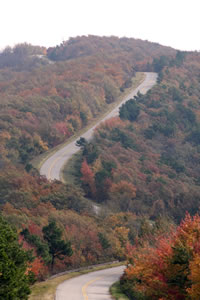- Forest Service Home
- Celebrating Wildflowers
- Home
- About Us
- News & Events
- Wildflower Viewing Areas
- Wildflower Ethics
- Forest Service Regions
- Just For Kids
- Teacher Resources
- Pollinators
- Native Gardening
- Native Plant Materials
- Invasive Plants
- Rare Plants
- Beauty of It All
- Interesting Plants
- Unique Communities
- Ethnobotany
- Special Features
- Wildflower Links
- Contact Us
USDA Forest Service Celebrating Wildflowers
|
|
|
Southern Region Viewing AreaLOCATION and PHOTOS
Talimena Scenic DriveForest: Ouachita National Forest District: Oklahoma and Mena/Oden Ranger Districts Description: The Ouachita Mountains were at one time a westward extension of the Appalachians. Therefore the plants of the Ouachita National Forest are similar to the eastern deciduous forest. Both geographically and climatically, the area may be considered a meeting ground of several biomes or plant formations. The Ouachita Mountains are different from most mountain ranges. The ridge line runs predominantly east-west rather than north-south. The east-west directional trend gives rise to distinct north slope and south slope plant and animal communities. The Talimena Scenic Drive spans the crest of Winding Stair and Rich Mountains. This scenic byway is 54 miles long and winds along forested mountains of the Ouachita National Forest between Talihina, Oklahoma and Mena, Arkansas. Trees near the mountain crests are dwarfed and gnarled and are the transition between the dry pine-oak forest of the south slope and the white-oak forest of the north slope. There are frequent vistas and trails which provide parking and the opportunity to explore the flora of the area. The scenic drive also offers historical sites, camping, picnicking, Visitor Information Stations, and Robert S. Kerr Memorial Arboretum and Nature Center and Botanical Area. Viewing Information: Throughout the year there are opportunities to view a multitude of wildflowers along the roadsides and trails. When viewing the mountains from the vistas you can see that the trees near the mountain crests are dwarfed and gnarled due to the constant pressure from prevailing south winds and the effect of winter icing from frequent freezing fogs, mist, and rain. The south slopes are occupied by shortleaf pines in almost pure stands or in mixed pine-hardwood forests and the north slope are dominated by hardwood species such as oaks and hickories. Common hardwood trees occupying the southern exposures are post oak, blackjack oak, black oak, southern red oak (at lower elevations), black hickory, and winged elm, with an under story of serviceberry, wild plum and farkleberry. These forests are also habitat to many wildflowers. Plants in the sunflower family such as the black-eyed Susan (Rudbeckia hirta), woodland sunflower (Helianthus divaricatus),blazing star and/or gayfeathers (Liatris sp.), asters (Symphyotrichum sp.), goldenrods (Solidago sp.) and pussy toes (Antennaria plantaginifolia) can be seen throughout the summer. Wildflowers such as butterfly pea (Centrosema virginianum), wild indigo (Baptisia leucophaea) and goat’s rue (Tephrosia virginiana) are a few of the many species of legumes that can be found in these communities. Mints such as dittany (Cunila origanoides),beebalm (Monarda fistulosa) and mountain mints (Pycnanthemum sp.) can also be found on these dries southern slopes. Warm season grasses such as poverty oatgrass (Danthonia spicata), little bluestem (Schizachyrium scoparium), Virginia wild rye (Elymus virginicus) are some of the more common grasses species encountered. Dominant trees on the north slopes include white oak, northern red oak, mockernut hickory, bitternut, black walnut, black locust, basswood, sugar maple, red maple, and at lower levels, beech. Under story trees include dogwood, pawpaw, Carolina silverbell, umbrella magnolia, Ohio buckeye, redbud and wild hydrangea. The north slopes, in particular, are an extremely rich habitat for spring wildflowers like green trillium(Trillium viridescens), fire pinks (Silene virginica), spiderworts (Tradescantia sp.) mayapple (Podophyllum peltatum) bloodroot (Sanguinaria canadensis), wild geranium (Geranium maculatum), wild comfrey (Cynoglossum officinale), common blue phlox (Phlox divaricata), rue anemone (Thalictrum thalictroides), wild hyacinth (Camassia scilliodes), false helebore (Veratrum woodii), and Jack-in-the-pulpit (Arisaema triphyllum). Safety First: Be prepared for changes in weather as thunderstorms may develop rapidly which is often followed by fog on the mountaintop. Watch your step when exploring, snakes may occasionally be present so please stay alert. Insect repellant is recommended to keep the ticks and chiggers away. If hiking in the summer temperatures can be high, 90 to 100 F so bring sunscreen and plenty of water. Poison ivy is common in most areas; remember leaves of three let it be. Directions: The Talimena Scenic Drive begins at the junction of US Hwy 271 and Oklahoma Highway 1 in the Ouachita National Forest about eight miles east of Talihina, Oklahoma. Start the road tour by driving Oklahoma Highway 1 east from US Highway 271 and continue on into Arkansas where the road number changes to Arkansas Highway 88. The Talimena Scenic Drive ends in Mena, Arkansas. You can find maps and additional information at the Ouachita National Forest website. Ownership and Management: U.S. Forest Service, Oklahoma and Mena/Oden Ranger Districts. Closest Town: From the west Talihina, Oklahoma; from the east Mena, Arkansas. |
|
| NOTE: PDF format links require the Adobe Acrobat Reader to view. | |
| top | Disclaimers | FOIA | Privacy Policy | Quality of Information | Photo Credits & Use |
Location: http://www.fs.fed.us/wildflowers/regions/southern/TalimenaScenicDrive/index.shtml
Last modified: Wednesday, 12-Oct-2011 15:53:08 EDT



